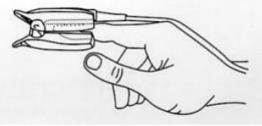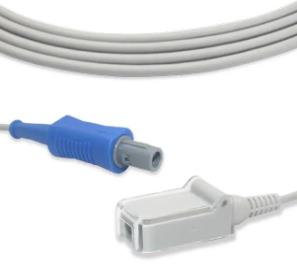Measurement principle
SpO2 plethysmogram measurement is employed to determine the oxygen saturation of hemoglobin in the
arterial blood. The SpO2 parameter can also provide a pulse rate signal and pulse strength. How the SpO2
parameter works
SpO2 is a non-invasive measurement of the functional oxygen saturation.
Arterial oxygen saturation is measured by a method called pulse oximetery. It is a continuous, non-invasive
method based on the different spectra absorption of hemoglobin and oxyhemoglobin (called
spectrophotometer principle). It measures how much light, sent from light sources on one side of the sensor,
is transmitted through patient tissue (such as a finger or a toe), to a receiver on the other side.
The sensor measurement wavelengths are nominally 660nm for the red LED and 940nm for infrared LED.
Maximum optical power output for LED is 4mw.
The amount of light transmitted depends on many factors, most of which are constant. However, one of
these factors, the blood flow in the arteries, varies with time, because it is pulsating. By measuring the light
absorption during a pulsation, it is possible to derive the oxygen saturation of the arterial blood. Detecting the
pulsation gives a PLETH waveform, pulse rate signal and pulse strength.
The SpO2 value, PR value, pulse strength and the PLETH waveform can be displayed on the main screen .
Measurement Steps
Sensor selection for SpO2 measurement depends on the patient’s age. For an adult patient, you can choose
an adult finger sensor; for a child patient, you can choose a child hand or toe sensor. The finger SpO2
sensor is a finger clip consisting of two parts. The LEDs are placed in one part and the photodetector is
placed in another part.
Please follow the steps and figure 6- 1 below to use the adult finger SpO2 sensor:
Insert the sensor’s connector to the Oximeter’s SpO2 socket.
Turn on the monition. The LCD screen will display the parameter monitoring screen. Attach the sensor to an
appropriate site of the patient’s finger.The readings will be displayed on the LED screen a moment later.
Make sure to place the SpO2 sensor oh the finger in a correct direction. The LED part of the sensor should
be at the backside of the patient hand and the photodetector part at the inside. Make sure to insert the finger
to a suitable depth into the sensor so that the fingernail is just opposite to the light emitted from the sensor.
To acquire accurate results, please read data until the sensor is steadily placed. Readings may not be
accurate when either the sensor or the patient is mov
Post time: Oct-09-2022



